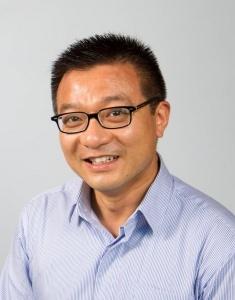
The work of Xiao Hu, PhD, almost makes the word “multidisciplinary” seem like an understatement. In addition to his primary home in the School of Nursing, the research scientist has appointments in the Departments of Neurology, Biomedical Engineering, Biostatistics and Bioinformatics, Surgery, and Electrical and Computer Engineering. For this week’s “Spotlight” interview, Hu talks to us about his work to use data science and engineering to improve the way we diagnose and treat patients with neurological conditions. He also discusses the joys of a career where every day is an opportunity for new learning, and his hopes for travel, hiking, and reuniting with colleagues once the pandemic is over.
How and when did you join the Neurology Department? What are your current roles and responsibilities here?
I am currently a faculty member with a secondary appointment and 20% effort in the Neurology Department, and my current role is to leverage my active NIH-funded projects to establish a strong translational research program that develops and tests data science approaches to equip care of patients with various neurological diseases with AI-driven clinical decision support capacities.
I was recruited by Duke School of Nursing from University of California San Francisco in January 2020. In anticipating active research projects in collaboration with colleagues in neurocritical care and other fields in neurology, becoming a faculty member in the Neurology Department was part of my recruitment.
How does your work across Duke complement or influence your work in the Neurology Department? What benefits are there for collaboration between these disciplines?
Indeed, I have secondary appointments in five different departments. One major factor that attracts me to Duke is that the University houses multiple disciplines on one campus, creating a unique opportunity to assemble a multi-disciplinary team to pursue research ideas.
My formal postgraduate training was in Biomedical Engineering and my advisor’s lab was two doors away from then 8-bed neurocritical care unit at UCLA Ronald Reagan’s Medical Center on the 7th floor of the old Center of the Health Sciences building. While taking courses in electrical engineering, statistics, computer sciences, and mechanical engineering, I spent time observing and collecting high-resolution physiological data from patients with acute brain injuries and normal pressure hydrocephalus and discussing findings with neurosurgeons and neurologists alike – hospital units were my lab. These activities in my five years of PhD study have had a profound impact on developing my abilities to have acumen of recognizing those unmet needs in clinical decision making process that can be solved with algorithms created to derive insights from data – now a burgeoning field called data sciences.
My secondary appointment with Biomedical Engineering, Electrical and Computer Engineering, and Biostatistics and Bioinformatics, will keep me rooted in these relevant quantitative science fields and my secondary appointment with Nursing, Surgery, and Neurology will enable me to deeply appreciate the clinical problems we are solving through the interactions with my clinical colleagues. As you can see, these appointments enable me in a unique way to bridge the gap between the health science campus and engineering field.
What are the biggest advances in your field since you got your doctorate? What do you see as the most important advance coming in the next decade?
As mentioned before, my doctorate study involved collecting and analyzing data from patients, but we were doing it one patient at a time. Nowadays, due to the wide adoption of electronic health records and ever increasing connectivity of medical devices, collecting rich data from all hospitalized patients across multiple institutions as part of the standard routine care has long become a reality. Coming in the next decade will be the continuing growth of data science and its penetration to leverage data to make basic science discoveries and impact clinical decision making in the diagnosis and treatment of patients.
What do you enjoy most about your work?
The best thing about my work are the vast opportunities every day to learn something new – could be a new algorithm idea in discussion with my graduate students and postdoctoral trainees, a new clinical problem we will be working on with collaborators, a new manuscript submitted to our journal (I am the editor-in-chief of Physiological Measurement), an inspiring talk given by my colleagues, or a hot-off the press paper triggering an idea for new projects.
What’s the hardest part of your job?
I am constantly yearning for more time – managing various demands and striking a work-life balance are hard. As a first-generation immigrant to the U.S., family support is critical and I am lucky that I always have that to help me get through various treacherous turns in our life.
What are you most looking forward to once the COVID-19 pandemic is over?
This pandemic has hit us hard. I am glad that there is finally light at the end of the tunnel and we can even start to think about what is ahead of us post the pandemic. This pandemic has taught us to appreciate what we used to take for granted. There are many things to look forward to but even having regular lunch meetings and coffee breaks with my colleagues and trainees would make my day!
What passions or hobbies do you have outside of the Department?
I enjoy traveling, hiking, and taking photos with an actual camera (not my iPhone). I am used to majestic landscapes in the west coast and will start to explore and appreciate a perhaps different landscapes on the east coast in the coming years – hopefully on foot a lot.

Xiao shares photos he took on a trip to Brussels (above) and Amsterdam (below) last year.
